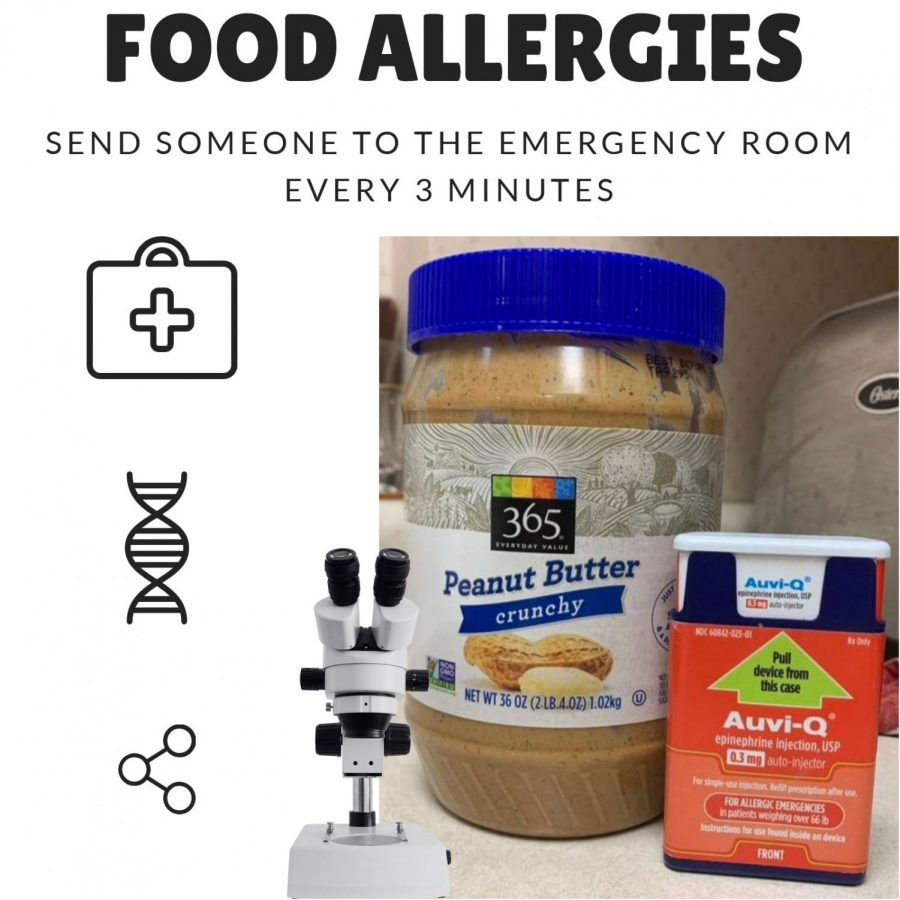How come there are so many students living with food allergies?
More and more students are experiencing complications with food allergies and the consequences that come with them.
March 9, 2020
The twenty-first century has seen an unprecedented increase in food allergies among children and adolescents, a trend that was far less common no more than 20 years ago. The diagnosis of people with anaphylactic food allergies has increased by 377 percent between the years 2007 and 2016. Approximately 32 million Americans live with a food allergy; 1 in every 13 children have a food allergy, which equates to roughly two students in every classroom. Food allergies are a severe medical condition that sends people to the emergency room every three minutes, according to Food Allergy Research and Education (FARE).
“When I was a kid, there were no food allergies. It’s unbelievable how many there are, and I don’t know if this is right or not but its that we use a lot of antibacterials and then the body mistakes it as a toxin. So I think we live in a cleaner society,” Orono High School nurse Anne Turner said.
However, before diving into the “how” and “why” behind food allergies, people must first address what a food allergy is and how it impacts the human body. Food allergies are caused by the overreaction of the body’s immune system to harmless substances as if they were dangerous viruses or bacteria. There are 8 types of food that account for nearly 90 percent of all anaphylactic reactions. These foods include eggs, milk, peanuts, tree nuts, fish, shellfish, wheat and soy, says the American College of Allergy, Asthma, and Immunology (ACAAI)
Due to this overreaction of the immune system, the body reacts in a variety of ways in order to protect the body from what it views as a dangerous intruder. While reaction types vary from person to person, symptoms of an allergic reaction can range from irritation of the skin, gastrointestinal tract, cardiovascular system and the respiratory tract. Depending on the person and the severity of the reaction, more than one of the systems are reactive to the allergen. Most of these reactions occur in a person within minutes but symptoms may start two hours after the initial ingestion, according to ACAAI.
“So, you have what are called B cells, and they recognize what are normally called antigens or they can also recognize an allergen. So somebody who is allergic to something has a B cell, let’s say for cats, that the regular population who’s not allergic don’t have for that cell. They have extra protection against something that’s normally not disease-causing,” Orono High School biology teacher Jeremy Buch said.
While all reactions to allergens are dangerous to the person experiencing it, the most severe and potentially life-threatening reaction is anaphylaxis. This whole-body allergic reaction can impair one’s breathing, cause a drop in their blood pressure and affect their heart rate. Many times it occurs within minutes of exposure or ingestion of the allergen, as stated by ACAAI.
It must be treated almost immediately with a dose of epinephrine, which is a type of adrenaline, that is administered to the body using an auto-injector prescribed by an allergist. Epinephrine works to stop allergic reactions by relaxing the muscles in the lungs and tightening the blood vessels to bring their functions back to normal, according to MedlinePlus.
“I think it’s important to be aware because if you’re ever in public and you see something strange, there’s a chance you’ll know what to do,” senior Anna Syversen said.
Visiting an allergist and completing thorough testing is the most effective way to dictate if someone, in fact, has a food allergy. The two most common tests that many allergists perform are the skin-prick test and a simple blood draw. The skin-prick tests can be more accurate than the blood test being that they provide the results to doctors within 20 minutes.
With a skin-prick test, allergists use a small probe and scrape a small amount of liquid containing an allergen on a patient’s arm or back. The scraping allows the liquid to seep underneath the topmost layer of the skin. If a reaction has occurred and a patient in fact tests positive for a certain allergen, a mosquito bite-like bump forms at the site where the allergen was placed, says ACAAI.
While many doctors are still unsure about the root cause, many hypotheses have come about after years of research. Scientists have developed a Hygiene Hypothesis that they believe helps to describe the increase in food allergies. The idea is that the world in the twenty-first century has become almost too clean, causing children to not experience exposure to common germs which creates a lack of training of their immune system in the differentiation between harmful and harmless substances, as reported by American Academy of Allergy, Asthma and Immunology. Although the Hygiene hypothesis is the most common hypothesis among scientists and allergists, however, lifestyle choices, diet and genetics could be a factor in the increase of food allergies within the past two decades, says the Mayo Clinic.
“I know a lot of people have developed food allergies over time because obviously I wasn’t born with mine, I used to be able to eat it [Pineapple]. I guess I never thought about it but I feel like I’ve realized a lot of people that start developing allergies\; I know my mom has developed allergies to more things as time has gone on. So yeah, I think we would call that an epidemic considering I feel that a lot more people have them,” junior Lauryn Pietrzak said.
While some may think food allergies are an untreatable condition that will most likely stick with them for the rest of their life, a new treatment is proving that thought wrong. With a new treatment using a peanut powder called Palforzia that is administered to people between the ages of four and 17 as an attempt to introduce the peanut protein into their body and allow their immune system to accommodate the once foreign and harmful substance.
From clinical trials, results showed that 67.2 percent of patients who received Palforzia tolerated a 600-milligram dose of peanut protein in the challenge, compared to 4.0 percent of patients receiving a placebo. Results were based on the effectiveness of the powder by measuring the percentage of participants that tolerated a 600-milligram dose twice a day for six months, as stated by the Food and Drug Administration (FDA).





























































